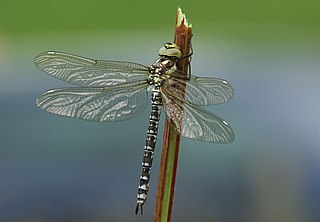
The chasers, darters, skimmers and perchers and their relatives form the Libellulidae, the largest family of dragonflies. It is sometimes considered to contain the Corduliidae as the subfamily Corduliinae and the Macromiidae as the subfamily Macromiinae. Even if these are excluded, there remains a family of over 1000 species. With nearly worldwide distribution, these are almost certainly the most often seen of all dragonflies.

Aeshna, or the mosaic darners, is a genus of dragonflies from the family Aeshnidae. Species within this genus are generally known as "hawkers" or "darners".

Argia is a genus of damselflies of the family Coenagrionidae and of the subfamily Argiinae. It is a diverse genus which contains about 114 species and many more to be described. It is also the largest genus in Argiinae. They are found in the Western Hemisphere. They are commonly known as dancers. Although the genus name comes from Ancient Greek: ἀργία, romanized: argia, lit. 'laziness', dancers are quite active and alert damselflies. The bluer Argia species may be confused with Enallagma species.

Erythemis is a genus of dragonflies in the Libellulidae family, commonly known as pondhawks. These medium- to large-sized skimmers are voracious predators of other insects up to their own size, including other dragonflies.

Sympetrum is a genus of small to medium-sized skimmer dragonflies, known as darters in the UK and as meadowhawks in North America. The more than 50 species predominantly live in the temperate zone of the Northern Hemisphere; 15 species are native to North America. No Sympetrum species is native to Australia.

Enallagma is a genus of damselflies in the family Coenagrionidae commonly known as bluets. Bluets can be distinguished from the similar vivid dancer by wing position; at rest, bluets' wings hang down on either side of their body, while vivid dancers hold their wings above their body. Bluets also have shorter leg spines.

Erpetogomphus is a genus of dragonfly in the family Gomphidae. They are commonly known as ringtails. Most of the species are predominantly green coloured and the males have a moderately clubbed tail. A fossil species are known from the Miocene Mexican amber

Erythrodiplax is a large Neotropical genus of dragonflies in the family Libellulidae. These small to medium-sized skimmers are commonly known as dragonlets.

Ictinogomphus is a genus of dragonflies in either the family Gomphidae or Lindeniidae. They are medium to large, yellow and black with clear wings. Species occur in Africa, Asia and Australia.

Ischnura is a genus of damselflies known as forktails in the family Coenagrionidae. Forktails are distributed worldwide, including various oceanic islands. The males have a forked projection at the tip of the abdomen which gives the group their common name.

Ophiogomphus, commonly known as snaketails, is a genus of dragonflies in the family Gomphidae. Most of the species in the genus Ophiogomphus have beautifully marked green club-shaped abdomens, which are more noticeable in the males.

Pantala is a genus of dragonfly in the family Libellulidae commonly called the rainpool gliders. They are found almost worldwide. Species of Pantala are medium-sized to large, dull orange-yellow dragonflies.

The pale-faced clubskimmer is a dragonfly of the family Libellulidae. Total length is 52 to 64mm.

Nehalennia is a genus of very small damselflies in the family Coenagrionidae. Most of the species are commonly known as Sprites. One species, N. speciosa occurs in Eurasia; the rest in North and South America.

Aphylla is a widespread Neotropical genus of dragonflies of the Gomphidae family. They are commonly known as the greater forceptails because of their forceps-like cerci.

Telebasis is a genus of damselflies in the family Coenagrionidae. The genus occurs in the Neotropics. Most of the species are red with a few blue species in South America.

Micrathyria is a Neotropical genus of dragonflies. They have bright green eyes and white faces. Most species have a markedly striped thorax. They are commonly known as Tropical Dashers.

Idiataphe is a genus of dragonflies in the family Libellulidae. The species are medium-sized, 34–42 millimetres (1.3–1.7 in) long. They occur from northeastern Argentina, through Brazil and the Antilles to Florida.
Brechmorhoga praecox, the slender clubskimmer, is a species of skimmer in the dragonfly family Libellulidae. It is found in Central America and South America.

Brechmorhoga rapax is a species of dragonfly in the genus Brechmorhoga. It is the most common member of the genus in Mesoamerica.





















